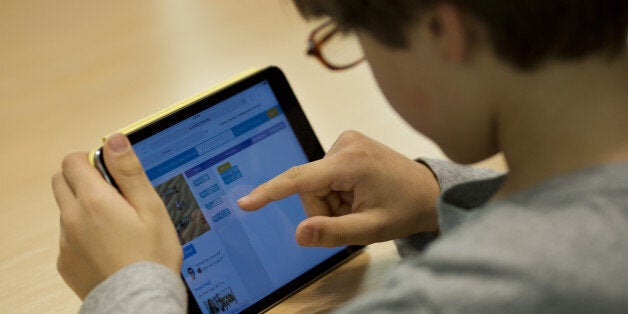
Thanks to advancements in technology, the teaching and learning landscape has changed irrevocably since Alaric Pritchard first took up the role of Associate Lecturer at The Open University back in 2001. And as a leading visionary in education technology, Pritchard has played no small part in effecting this transformation at the OU.

The managing director of a thriving project management company, Pritchard, like most of his fellow tutors at the OU, is a practitioner in the subject he teaches, enabling him to combine extensive industry experience with academic course material. And as a former OU student with disability, he is no stranger to the challenges faced by students – particularly those juggling their studies with work commitments.
We spoke to Pritchard to find out how technology is enabling students at the world’s leading distance-learning provider to feel anything but distant – and to share his predictions on the future of digital learning.
What's the role of Associate Lecturers at The Open University?
The Associate Lecturers are the face of the OU: the people that students interact with on a day-to-day basis; the people who teach; the people who give them feedback and marks. Some of it is about what I would call regular teaching and some of it is about giving them support and guidance.
Another important part of the role is making the learning material come alive for the students and making it personal for them. With the internet, there’s more material available than ever before. The question is: how does the student understand and apply that material? And that’s where Associate Lecturers come in.
One of the big benefits of The Open University model is that it is full of practitioners like myself. I run a business and I also teach about business. In that sense, the Associate Lecturers are very contemporary because they do it every day and they understand the pure theory.
What forms of contact do the students have with the Associate Lecturers?
We have face-to-face teaching in the form of traditional tutorials, which is great – and we have email and phone calls. But we also use technology in new and innovative ways, like synchronised teaching. For instance, I have a strategy course with students from all over mainland Europe so I'll bring them together on a web conference and we'll run a session very similar to how we’d do face-to-face.
These technological advancements must have changed the learning landscape considerably since your appointment as an Associate Lecturer back in 2001?
Yes, when I first started teaching, students would print out their assignments and post them. I would get them in my letterbox and manually mark them by hand. That works after a fashion but in terms of today’s students, I think they want much more timely feedback, much more personalised learning experience – and technology enables us to do that. Now the students submit their work to us electronically and we mark it electronically and feed everything back through a centralised hub. We can provide on-line activities such as discussion forums to build a sense of community.
What kind of students do you deal with at The Open University?
The first founding mission of The Open University was that it was meant to be available to everybody and to remove barriers to education – and that's what it's still very good at. It has a really diverse range of students: old, young, working, non-working – and because of technology, geography is not an issue, so we have students from all over the globe.
Bringing students together who collectively have a considerable work history is one of the great benefits. We can have a call or a face-to-face where there’s probably 50 or 60 years’ work experience in the room. That diversity can be really helpful, because it gives us lots of information we can compare and contrast. My previous presentation included a company director, a RAF helicopter pilot and a mother returning to employment, each with really valuable perspectives.
With such a diverse student population, how do you tailor your teaching to accommodate their individual needs?
Technology is a great enabler when it comes to the student experience. If a student has a particular need, I can say, ‘perhaps your assignment appears to need some more work here, this is what you scored. I suggest you click on this link and go through these exercises’. Rather than having the same mistakes time and time again, I can start to put tailored interventions in place.
If I have a student with, say, visual impairments, I can say, ‘That’s okay, I’ll provide you with an audio recording of your feedback for you’. So rather than typing it in the transcript, they can hear my voice in the first person.
Has technology changed the way people study and learn?
Technology has enabled students to customise how they want to learn like never before. It’s no longer a case of you have to turn up on a Saturday or you have to watch a television programme. You can be quite flexible with your lifestyle – which is great because most students are time poor.
For instance, we now find students increasingly using audio recordings. The reason being, they’re commuting for an hour or two hours a day in the car or the only time they’ve got is in the gym. Now they can listen to the audio and study at the same time – all while they’re at the gym!
What drew you to learning technology?
I have a disability called Charcot-Marie-Tooth, which affects my extremities and my mobility. Initially, I found school very difficult and never achieved what I should have achieved. But as I got older and technology developed, I began to see potential. The things I could never do at school because the technology wasn’t there, suddenly I could do. So I went back to education late, in my mid twenties, as the technology was there to enable me to achieve. That gave me the confidence to achieve in other areas, for example I hold British and World track cycling records for my disability classification.
How has your experience as a former Open University student helped to shape your role at OU?
I think it’s a very humbling experience and it’s good in a number of ways because rather than me homogenously saying this is what students think – I've actually been there. I've sat there eagerly awaiting my marks, I've had feedback and I've had to apply what my tutors told me so I've experienced it first-hand – and that's really helped me refine my practice.
I did a Masters degree in Education at the OU because I wanted to pursue how technology can enhance learning. I want to influence and I would like others to learn from the things I’ve learned from so they can improve their practice. I’ve just put in my doctorial proposal to do a Doctorate in Education. This landscape is moving so fast, you have to keep on top of it. For example I don’t type any more – I talk to my computer and it does my typing for me.
What direction is learning technology headed?
There are some great products available now, like Microsoft One Note, which is a fabulous synchronised note-taking tool. Rather than taking traditional notes on paper or in a Word document, students can start to build synchronised notes in real time, ready for revision and ready for learning. Students now are used to taking photos, posting things to Facebook, posting stuff to Whatsapp including adding caption images.
There are also some really big, interesting areas around Massive Open Online Courses (MOOCS) too. The OU's approach – with a lot of the other universities – around FutureLearn is suddenly opening up landscapes we never had before.
You were recently awarded the prestigious Microsoft Innovative Educator (MIE) expert award. Can you tell us more about that?
MIE is an exclusive programme that brings together what Microsoft call ‘global educator visionaries’ to explore how technology can pave the way for better learning. It's a social network that enables myself, and colleagues from around the world, to learn from each other and share ideas, concepts and best practice.
There are lots of things within the Microsoft space we can use for education, like Sway – and One Note, which we’ve talked about already. We get access to new products in Beta form so we get to play with things before they go into production. It’s about sharing what we do as a learning community and how we can assist each other globally to improve our practice to improve the student experience and outcomes.